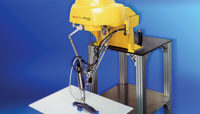Traditionally, plant layout has focused on linear lines and process-based departments. But, assembly lines have changed dramatically in recent years due to trends such as just-in-time delivery and parts sequencing.
There are nine common line layout mistakes that manufacturing engineers should avoid:
1. Poor Planning.
“In the front end, poor planning is a frequent mistake,” says Sammy Obara, president of Honsha Associates. “At Toyota, when we put together a plan—usually on an A3 form—our Japanese sensei would scrutinize us with questions such as: ‘What other Toyota sites did you compare against?’; ‘How flexible is this line for demand fluctuation?’; and ‘How will the operator handle this part? One hand? Which one?’ Planning must be deep enough to answer all possible aspects of the new line. Otherwise, it is poor planning.”
2. Preparing Standards.
“The least glamorous part of putting together a new line or process is the standardized work part of it,” claims Obara, who spent three years studying lean manufacturing principles in Toyota City, Japan, and another 10 years applying it at Toyota plants in Brazil, Venezuela and the United States. “Once the line is running, people tend to move to new and more visible executions. Preparing standards is not as visible and it almost hides from view. However, it is in the foundation of the house of lean. That’s a funny analogy, because in a real brick house, nobody sees the foundation. Still, it is what [keeps] the house standing firm.”
3. Material Flow.
“One common mistake is not incorporating proper material flow concepts into the layout design,” notes Matt Zayko, an associate at the Lean Transformations Group. “There should be simple material delivery routes and pathways throughout the facility that connect the processes. Also, there needs to be a plan for flexbility and changes, since volumes and demand are variable.”
4. Leaping Before Looking.
“The single biggest mistake is to go directly to floor plans and arrangements without resolving fundamental issues,” claims Quarterman Lee, president of Strategos Inc. “Jumping into the design without a process for the design and with little awareness of the many factors involved [is a mistake]. Such projects start out great, but quickly bog down in unresolved issues, lack of consensus, confusion and delay. The resulting layout is usually a poor variation of what currently exists.”
5. Demanding Perfection.
“One common mistake is to think that the new layout and equipment must be designed perfectly before implementation,” says Kurt Greissinger, industry manager for assembly and handling at Bosch Rexroth Corp. “Near perfection might be achievable, but it comes at the expense of design time. A rule of thumb is to get it 70 percent to 80 percent of the way designed before implementation and then use a continuous improvement process to create the ideal layout.
“Another mistake is to think that you can take the current state and use continuous improvement to reach the goal,” warns Greissinger. “This also takes considerable time. Often, it is best to make some large, radical changes to get it to the 70 percent or 80 percent level, and then use continuous improvement efforts from there.”
6. Maintaining Tradition.
“A successful lean layout requires changing the mind-set from traditional manufacturing,” says Don Penkala, president of Granite Bay Global. “Lean requires small production batch sizes (ideally, but not necessarily, sizes of one); smaller, modular equipment; cells and lines that handle only a certain set of products; and a commitment to lead time reduction, asset reliability and quality improvement rather than equipment and labor efficiency and utilization.
“A common mistake in implementing lean layouts is maintaining traditional manufacturing strategies while trying to install physical flow,” Penkala points out. “The result is often a layout that is efficient only on paper, while inventories, lead times and costs remain high.
“This can be avoided by thoroughly understanding how lean flow principles fundamentally require changes in procurement strategy; performance measurement; employee training, engagement and accountability; and production planning, scheduling and control,” adds Penkala. “It is a mistake to think that the benefits of lean can be achieved simply by understanding the tools and changing the layout of equipment.”
7. Bigger Isn’t Better.
“Bigger is not always better,” claims Drew Locher, managing director of Change Management Associates. “This applies to equipment and facilities. Right-sized equipment and facilities are the key. All equipment and facilities should be designed to the demand rate or takt time, rather than ‘let’s build the biggest facility that we can on the site or design the fastest and largest piece of equipment possible.’”
8. Keep It Simple.
“One big mistake is to forget the keep it simple rule,” says Locher. “For example, we have walked into many companies that have very complex and expensive material handling systems installed to ‘automate’ the transportation waste that exists. People kid themselves if they think that such ‘automation’ removes non value-adding transportation entirely. Other non value-added activities are created as a result, such as the ongoing maintenance of these systems. The systems were never really needed if people had considered applying continuous flow concepts.”
9. Making Assumptions.
“Making assumptions is another mistake,” notes Locher. “Too often, people assume constraints when they really don’t exist. There is an assumption that ‘we must make use of existing workstations and equipment as they are today.’ However, workstations can be reduced in size or replaced all together to accommodate a cellular layout.
“Equipment can be slightly modified in ways to promote flow,” adds Locher. “A little bit of creativity can help overcome some seemingly formidable obstacles to continuous flow. Finally, do not forget about balance. I have walked into too many [plants where people] proudly show me their layout, but where work-in-process inventory still piles up due to imbalances between processes.”



